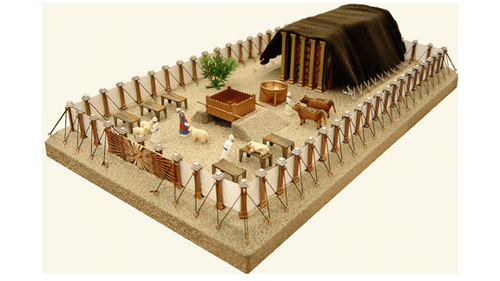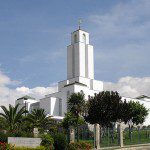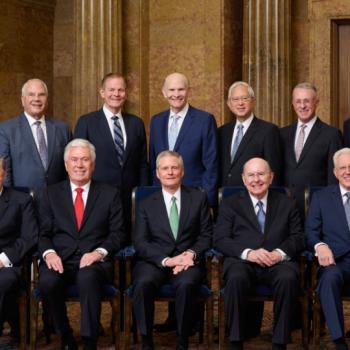
(Wikimedia Commons public domain image)
***
New today (Tuesday) on the website of the Interpreter Foundation:
Jonn Claybaugh: Come, Follow Me — D&C Study and Teaching Helps: Lesson 37, September 6–September 12: D&C 98-101 — “Be Still and Know That I Am God”
The Interpreter Radio Roundtable for Come, Follow Me Doctrine and Covenants Lesson 37, “Be Still and Know That I Am God” on D&C 98-101, featured Neal and Jasmin Rappleye and Hales Swift. Now, it has been extracted from the 1 August 2021 broadcast of the Interpreter Radio Show. The complete show may be heard, sadly bereft of commercial and other interruptions and at no charge, at https://interpreterfoundation.org/interpreter-radio-show-august-1-2021/. The Interpreter Radio Show can be heard every Sunday evening from 7 to 9 PM (MDT), on K-TALK, AM 1640. Or, alternatively, you can listen live on the Internet at ktalkmedia.com.
***
And here are links to a few articles that you might enjoy from a prior issue of Interpreter: A Journal of Latter-day Saint Faith and Scholarship:
Daniel C. Peterson, “A Note in Favor of Rereading Great Works, Including the Scriptures”
Abstract: When I was young, I learned an important lesson that has stayed with me through my life. This lesson has led me, on many occasions, to reread great works by great authors. The scriptures are no exceptions, and rereading them can be beneficial to any reader.
Joshua M. Sears, “An Other Approach to Isaiah Studies”
Abstract: A recent review of Joseph M. Spencer’s book The Vision of All: Twenty-Five Lectures on Isaiah in Nephi’s Record made the case that the book contains several challenges and problems, in particular that it advocates a theologically deficient interpretation of Isaiah that denies Isaiah’s witness of Jesus Christ. This response provides an alternative reading of Spencer’s work and suggests these assertions are often based on misunderstanding. At stake in this conversation is the question of whether or not there is more than one valid way to read Isaiah that draws upon a faithful, Restoration perspective. While Spencer may interpret and frame some things differently than some other Latter-day Saint scholars, the prophecies of Isaiah provide enough richness and possibility to accommodate a chorus of faithful approaches.
Donald W. Parry, “The Importance of Authorial Intention”
Abstract: It is important when evaluating the words of others to consider the intention of their writing. It also does not hurt to consider what may go on behind the scenes before an article (or a book review) even reaches a particular readership.
John Gee, “How Not to Read Isaiah”
Abstract: In the Book of Mormon, Nephi draws upon his own knowledge of the Jewish people, their culture and language, and the surrounding area to add to his understanding of Isaiah’s words, and commends that approach to his reader. In his book The Vision of All, it is clear that Joseph Spencer lacks knowledge in these topics, and it negatively affects his interpretation of Isaiah. Specifically, this lack of knowledge causes him to misinterpret the role of the Messiah in Isaiah’s teachings, something that was clear to Isaiah’s ancient readers.
Review of Joseph M. Spencer, The Vision of All: Twenty-five Lectures on Isaiah in Nephi’s Record (Salt Lake City: Greg Kofford Books, 2016). 318 pages. $59.95 (hardback); $29.95 paperback.
Matthew B. Brown, “Cube, Gate, and Measuring Tools: A Biblical Pattern”
Abstract: This article explores the biblical pattern that relates the temple-related symbols of the cube, the gate, and measuring tools. The tools of architecture and measurement were associated with the kingship motifs of creation and conquering chaos, and on the day when a person was initiated as a king in ancient Israel, all of these concepts were applied to him.
[Editor’s Note: Part of our book chapter reprint series, this article is reprinted here as a service to the LDS community. Original pagination and page numbers have necessarily changed, otherwise the reprint has the same content as the original.
See Matthew B. Brown, “Cube, Gate, and Measuring Tools: A Biblical Pattern,” in Ancient Temple Worship: Proceedings of The Expound Symposium 14 May 2011, ed. Matthew B. Brown, Jeffrey M. Bradshaw, Stephen D. Ricks, and John S. Thompson (Orem, UT: The Interpreter Foundation; Salt Lake City: Eborn Books, 2014), 1–26. Further information at https://interpreterfoundation.org/books/ancient-temple-worship/.]
Kevin Christensen, “Table Rules: A Response to Americanist Approaches to the Book of Mormon”
Review of Elizabeth Fenton and Jared Hickman, Americanist Approaches to The Book of Mormon (New York: Oxford University Press, 2019). 456 pages. $99 (hardback), $35 (paperback).
Abstract: Americanist Approaches to The Book of Mormon is an ambitious collection of essays published by Oxford University Press. By “Americanist” the editors refer to their preferred mode of contextualization: to situate the Book of Mormon as a response to various currents of nineteenth- century American thought. The “table rules” in this case determine who gets invited to the table and what topics can be discussed, using what types of evidence. The approach is legitimate, and the contributors offer a range of interesting perspectives and observations. Several essays base their arguments on the notion that the Book of Mormon adapts itself to a series of racist tropes common in the nineteenth century. In 2015, Ethan Sproat wrote an important essay that undercuts the arguments of those authors, but none of them address his case or evidence. This raises the issue of the existence of other tables operating under different assumptions, confronting the same text, and reaching very different conclusions. How are we to judge which table’s rules produce the best readings?
L. Michael Morales, “The Tabernacle: Mountain of God in the Cultus of Israel”
Abstract: In this article, Michael Morales considers how the building of the Tabernacle had been pre-figured from the earliest narratives of Genesis onward. It describes some of the parallels between the creation, deluge, and Sinai narratives and the tabernacle account; examines how the high priest’s office functions as something of a new Adam; and considers how the completed tabernacle resolves the storyline of Genesis and Exodus, via the biblical theme of “to dwell in the divine Presence.”
[Editor’s Note: Part of our book chapter reprint series, this article is reprinted here as a service to the LDS community. Original pagination and page numbers have necessarily changed, otherwise the reprint has the same content as the original.
See L. Michael Morales, “The Tabernacle: Mountain of God in the Cultus of Israel,” in Ancient Temple Worship: Proceedings of The Expound Symposium 14 May 2011, ed. Matthew B. Brown, Jeffrey M. Bradshaw, Stephen D. Ricks, and John S. Thompson (Orem, UT: The Interpreter Foundation; Salt Lake City: Eborn Books, 2014), 27–70. Further information at https://interpreterfoundation.org/books/ancient-temple-worship/.]
Posted from Newport Beach, California











